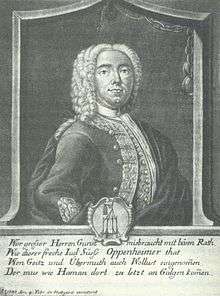Joseph Süß Oppenheimer
Joseph Süß Oppenheimer (1698? – February 4, 1738) was a German Jewish banker and court Jew for Duke Karl Alexander of Württemberg in Stuttgart. Throughout his career, Oppenheimer made scores of powerful enemies, some of whom conspired to bring about his arrest and execution after Karl Alexander's death.
Joseph Süß Oppenheimer | |
|---|---|
 | |
| Born | 1698/1699 |
| Died | February 4, 1738 (aged 39) |
| Occupation | Court Jew |
In the centuries since his execution, Oppenheimer's rise and fall have been treated in two notable literary works, and his ordeal inspired two films, including the antisemitic production Jud Süß, released in Nazi Germany in 1940, itself the cause for a famous postwar trial.[1]
Career
Oppenheimer was born in Heidelberg to a Jewish tax collector and his wife. The father died early, and the exact whereabouts of Joseph Süss in the following years are not certain. By the 1720s, however, Oppenheimer was already working as a court Jew in Mannheim, Darmstadt, and finally Frankfurt am Main, where he was introduced to Karl Alexander, the future Duke of Württemberg, in 1732. When Karl Alexander ascended the throne in the following year, Oppenheimer served as his chief financial adviser.
Arrest, trial and execution
When his protector, Karl Alexander, suddenly died on March 12, 1737, Oppenheimer was arrested and accused of various crimes, including fraud, embezzlement, treason, lecherous relations with various women, and accepting bribes. While some Jews tried to help him during the trial, others gave incriminatory testimonies against him. Most of the accusations could be refuted, and the charge of lechery was dropped in order to protect reputed women.
After the heavily publicized trial, Oppenheimer was sentenced to death, without naming any specific crime. When his jailers asked that he convert to Christianity, he refused.

Joseph Süß Oppenheimer was led to the gallows on February 4, 1738, and given a final chance to convert to Christianity, which he refused to do. He was throttled,[2] with his last words reportedly being the Jewish prayer, "Hear, O Israel: the Lord is our God, the Lord is one".
The case records were then declared secret, so until 1918 no one could realize the judicial murder done to him. His corpse was gibbeted in a cage that hung outside of Stuttgart in the Pragsattel district for six years until the inauguration of Karl Eugen, Duke of Württemberg, who as his very first act as ruler permitted the burial of his corpse below the gallows.
In literature, art and film
The story of Joseph Süß Oppenheimer was the subject of a number of literary and dramatic treatments over the course of the past two centuries.[3] The earliest of these having been Wilhelm Hauff's 1827 novella titled Jud Süß.[4] The most successful literary adaptation was Lion Feuchtwanger's 1925 novel titled Jud Süß based on a play that he had written in 1916 though never performed and subsequently withdrawn by Feuchtwanger.
Ashley Dukes and Paul Kornfeld also wrote dramatic adaptations of the Feuchtwanger novel. In 1934, Lothar Mendes directed a film adaptation of the novel in which Süß was portrayed by actor Conrad Veidt.[5]:42–44 An anti-semitic Nazi propaganda film titled Jud Süß was made in 1940 by Veit Harlan, in which Süß was portrayed by actor Ferdinand Marian.
In the 1990s, the German sculptor Angela Laich created a sculpture devoted to Joseph Süß Oppenheimer as well as illustrations for Hellmut G. Haasis's biography.
In 2016 the movie Norman: The Moderate Rise and Tragic Fall of a New York Fixer was released, loosely inspired by Oppenheimer's life, starring Richard Gere.
Biographies
Shortly after Feuchtwanger's novel was published, Selma Stern published a biography of Oppenheimer titled Jud Süß: Ein Betrag zur deutschen und zur jüdischen Geschichte. More recently, Hellmut G. Haasis published a biography titled Joseph Süß Oppenheimer, genannt Jud Süß: Finanzier, Freidenker, Justizopfer. It is still the standard work on the topic. In 2017, Yair Mintzker, a history professor at Princeton University, published a new account of Oppenheimer's trial, The Many Deaths of Jew Süss, which is the most comprehensive treatment of Oppenheimer's trial available in English.
References
- Mintzker, Yair (2017). The Many Deaths of Jew Süss : The Notorious Trial and Execution of an Eighteenth-Century Court Jew. Princeton: Princeton University Press. ISBN 9781400887804.
- Not hanged, the gibbet was only used to hang the cage where his body was placed.
- Tegel, Susan (2011). The Jew Süss : His Life and Afterlife in Legend, Literature and Film. London: Continuum. ISBN 9781847250179.
- Chase, Jefferson S. (1998). "The Wandering Court Jew and the Hand of God: Wilhelm Hauff's 'Jud Süss' as Historical Fiction". Modern Language Review. 93 (3): 724–740. JSTOR 3736493.
- B. Haines; S. Parker (March 17, 2010). AESTHETICS AND POLITICS IN MODERN GERMAN CULTURE. Peter Lang. ISBN 978-3-03911-355-2. Retrieved October 27, 2011.